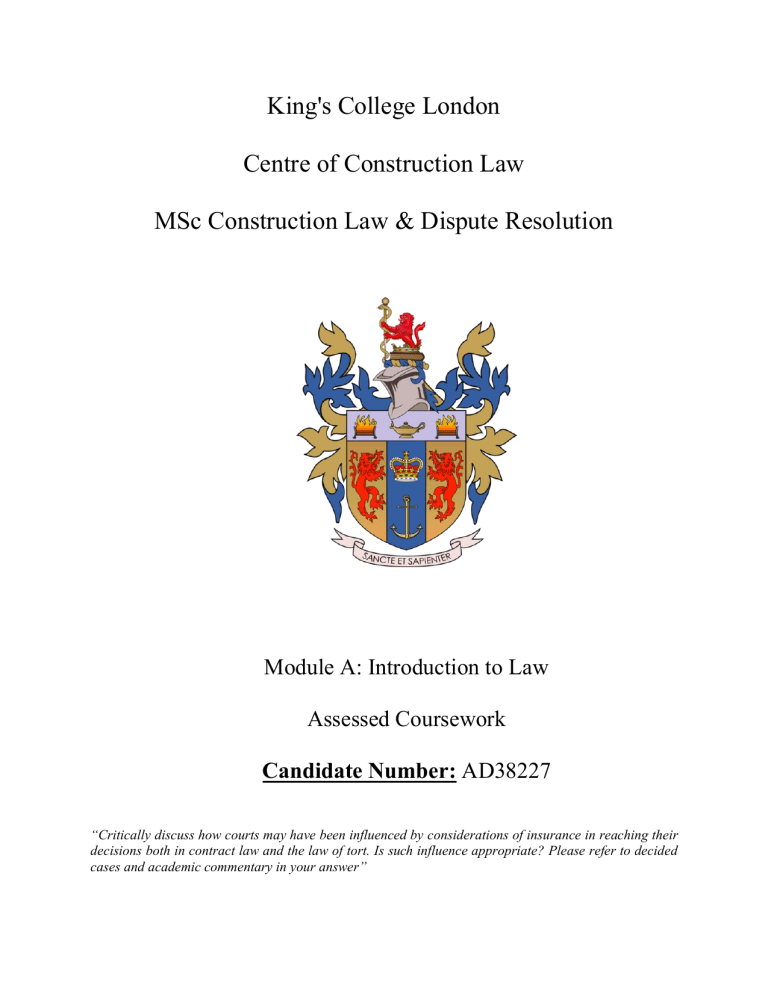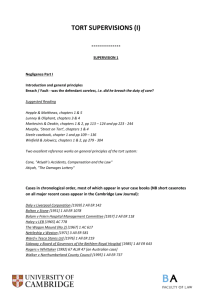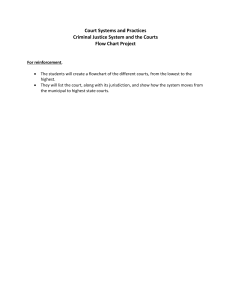
King's College London Centre of Construction Law MSc Construction Law & Dispute Resolution Module A: Introduction to Law Assessed Coursework Candidate Number: AD38227 “Critically discuss how courts may have been influenced by considerations of insurance in reaching their decisions both in contract law and the law of tort. Is such influence appropriate? Please refer to decided cases and academic commentary in your answer” I. Introduction Insurance is, by definition, a policy under which a company or the state undertakes to compensate against a specified loss or damage 1. The policy is a contract that includes provisions regulated by rules and regulations set out by insurance law. However, insurance is presumed to have an influence in areas not only in insurance law contracts, but also in general contracts law and tort law. Contrary to past views that accounting for insurability, when deciding a case, would be focusing on distributive justice instead of principles of facts, the contemporary reality is that insurance considerations have been present in the court judgements, partly due to the judge gaining knowledge of the extent of the insurance coverage of the parties to the claim2. This essay describes the influence of insurance observed in court judgements in areas of contract law and in tort law, in addition to assessing whether it was contributory to establishing justice. II. Contract Law a. Influence of “joint insurance” clauses A joint names policy is an insurance which is often present in construction contracts. It consists of preventing the insured parties from bringing claims against one another in regard to the insured losses3. The courts’ interpretation of the joint insurance clauses has caused ambiguity on the extent of its application. The effect of this clause is brought in cases where a breach of the contract occurs, by negligence, causing damage supposedly covered by joint insurance and raising the question of whether the damages can be claimed from the negligent party. In the context of construction, joint names insurance clauses do not seem to protect the damaging party from liability as courts will critically determine its scope and will not put weight on the presumed will of the parties at the outset of the contract. As presented in the case of Tyco Fire and Integrated Solutions Ltd v Rolls Royce Motor Cars Ltd 4. The case describes the malfunction of a main water pipe negligently installed by Tyco, a subcontractor appointed by Rolls Royce. The dispute is over the eligibility of the main contractor to claim damages caused, by the water flooding, to the existing part of the building. Tyco, oppositely, is claiming its protection by the joint insurance clause. The court held that the joint insurance clause, although not fulfilled by Rolls Royce, did not extend its coverage to existing structures of the building due to the presence of an indemnity clause in the contract referring to the liability of Tyco for the caused damage 5. 1 Oxford English Dictionary, second edition (1989) The Modern Law Review, Vol. 75, No. 3 (MAY 2012), pp. 301-323 3 Jenny Savage and Will Sefton, Joint Names Insurance And Risk Allocation In Construction Projects, CMS Cameron McKenna Nabarro Olswang LLP. 4 (2008) EWCA Civ 286 5 John D Wright, Insurance requirements in construction contracts (socup.org.uk, 08 December 2021) < https://www.socup.org.uk/knowledge/underwriting/articles/insurance-requirements-in-constructioncontracts/6959#:~:text=The%20rationale%20behind%20these%20decisions,remains%20as%20fluid%20as%20ever. > accessed 20 December 2022 2 However, Rix LJ commented in obiter, that there is a necessity of caution when drafting contracts with joint names insurance clauses as to define the extent of the insurance coverage and to the inclusions of indemnity clauses. As opposed to the construction industry, the marine industry has maintained a clearer view on joint names insurance clauses in marine contracts. The court also commented unfavourably on the previous Tyco v Rolls Royce case, insisting on the importance of giving weight to parties’ intention translated by the presence of a joint name insurance, which is to protect both parties from their own negligence 6. A case demonstrating the view on joint insurance clauses is Gard Marine & Energy Ltd v China National Chartering Co Ltd 7, where Gard Marine, the insurer, sought to bring subrogated charges against the sub-charterer claiming for damages caused on the vessel by breach of a “safe port” warranty. The sub-charterer claimed being protected by the joint name insurance. The court held that the contract prima facie reflects the will of the parties to transfer the indemnification to the insurer rather than to each other. This shows that the interpretation of the joint name insurance by courts could protect the party who committed a breach of contract in the case where it clearly mentions that the intention of the contracting parties is to seek relief from liability. Whilst the “safe port” warranty was regarded as insufficient in this case, the indemnity clauses in the Tyco contract were enough to tilt the balance against enforcing the joint name insurance clause. The consequence of both cases is to highlight the need to carefully consider the insurance clauses in the construction contracts as it can sway the judgement of the courts accordingly 8. b. Limitation and exclusion clauses Contracts often include clauses limiting or excluding liability which adhere to the doctrine of freedom of contract. However, statutes such as the Unfair Contracts Terms Act 1977 and the Sale of Goods Act 1979, dictate a set of rules assessing the unfairness of limitation and exclusion clauses 9. Not restricted to the latter, considerations of insurance have also played a role in courts’ judgments on disputes over limitation and exclusion clauses. A possible influence of insurance consideration over court judgments is the likelihood of deeming an exclusion or limitation clause reasonable when an alternative remedy exists. When the issue relates to business profit, courts will be inclined to rule in favour of the damaging party as it supposes that such losses are insurable. In Regus v Epcot Solutions 10, the contract included a limitation of liability clause benefitting Regus, who sought enforcing it in order to be relieved from paying damages to Epcot following a loss of business profit due to a malfunction of the airconditioning system in the rented workspace. The court allowed the appeal and provided that the limitation clause is enforceable. The arguments employed included a consideration of the 6 L.L.I.D. 2017, May 18, 6 [2017] UKSC 35 8 Const. L.J. 2008, 24(1), 60-73 9 Burrows FBA Q (Hon), Cartwright J and Beatson FBA J, Anson’s Law of Contract (31st edition, Oxford University Press 2020) 10 [2008] EWCA Civ 361 7 possibility for Epcot to have insured against loss of business profit, which is an alternative remedy to the risks presented by the exclusion clause and therefore cannot be deemed unreasonable. The views of the courts, as evident in the above, are to consider the possibility of obtaining an insurance, to cover a certain risk, when assessing the merits to the claim, in the presence of a limitation or exclusion clause. Similarly, in a construction contract between a client and a consultant, it is common to have a net contribution clause (NCC) in the benefit of the consultant. Therefore, the client should be advised that the insolvency risk of a contractor appointed by them should be covered by insurance as it is not a possibility for the consultant 11. The court has adopted this approach in West v Ian Finlay12, where the Wests appointed IFA to refurbish a newly bought property and entered into a contract including an NCC. The latter specified that the liability of IFA was excluding the work done by parties appointed by the Wests. The Wests sought to claim for all the damage caused by major defects from IFA only, as the other contributor to the defects became insolvent. On the other hand, IFA defended by demanding enforcement of the NCC and excluding, from the damages sought, the liability of the insolvent party, as it was appointed by the Wests. The court held that the NCC was unambiguous and therefore created equal bargaining power between the parties of the contract, therefore concluding that it was enforceable. Not exclusively, the court considered that the risk of insolvency of a party appointed by the Wests should be borne by them, as, unlike IFA, they were able to cover that risk through insurance. Hence, it can be concluded that the courts will be swayed to judge that a limitation of liability or exclusion clause is reasonable based on the possibility of a party to protect themselves, through an insurance policy, against the risk imposed by the clause III. Tort Law – Duty of care c. Economic Loss Tort law has sought to safeguard parties from a floodgate of liability. This has been possible through considerations of insurance in the courts’ judgments. Courts adopt the view that a damaging party is to be protected, from the risk of being held liable, by the rules against the recovery of pure economic loss or consequential losses. Without the previously stated rule, contractors will be incentivised to not take proper care in the conducted works, as the likelihood and the impact of an accident occurring are “crushingly great” 13. In Spartan Steel Alloys v Martin Ltd (1972)14, where an aluminium smelter had his electricity negligently cut off by an employed contractor and consequently interrupted the supply for several hours. In addition to damages claims, Spartan sought to recover a loss of potential profit had the interruption not occurred. The court considered that recovering the named losses cannot be conducted through the contractor and rather could have been done through an insurance policy covering the events of loss of profit. 11 Hudson's Building and Engineering Contracts 14th Ed, Section 2.3 (5). [2014] EWCA Civ 316 13 Philip Sales, Pure economic loss in the law of tort: the history and theory of assumption of responsibility, 26 September 2022. 14 [1973] Q.B. 27 12 The liability, in tort, of a solicitor negligently failing to convey the wishes of the testator towards the beneficiaries is present as there will be legal responsibility 15. The establishment of this liability was in the case of White v Jones16. Solicitors had failed to update the will of the father of the defendants who successfully brought claims of damages under the breach. The court dismissed the appeal of the solicitors deliberating that the assumption of responsibility applies to them as the consequence of an unenforceable will should be foreseen consequent to an act of negligence from their side. Additionally, the court has considered that, in practice, “there should be no difficulty in obtaining adequate insurance cover. In practice, solicitors are covered in respect of such risks under ordinary professional indemnity policies.” The abovementioned reflects the courts’ considerations of insurance, reflected in the judgements, that the party to be held liable, in a case of economic loss in tort, is the party who would “normally” be covered by insurance 17. d. Occupier’s liability Considerations of insurance are not only taken in cases of breach of duty of care causing economic losses but are also present in the judgements on the duty of care owed to the occupier of a property. Courts have adopted the view that confirming the presence of an insurance policy is regarded as a necessary limb of the duty owed by the proprietor. In Gwilliam v West Hertfordshire Hospitals NHS Trust,18 the claimant was injured at a fair organised by the hospital who employed “Club Entertainment” to operate it. The court insisted on the duty of care owed by the hospital towards the attendees of the fair and therefore should ensure that the operators should have an insurance against the risk of breach. The previous judgment was distinguished in Naylor v Payling,19 an incident had occurred where Payling sustained an injury through an altercation with the security staff employed by the nightclub owner, Naylor. The court substituted the need for ensuring that the employed party is insured by it being a certified server provider. However, more recently, the courts have been more lenient in finding proprietors liable for the occupiers’ damage or injury within their premises. The requirement for insurance against this specific risk has been subject to the reasonableness of the care taken by the party receiving the damage. In Edwards v London Borough of Sutton20, the plaintiff is an individual who was crossing a narrow, unguarded bridge and fell off of it and sought to bring claims on the council for breaching their duty of care. McCombe LJ adopted the view that despite severe loss caused by an accident there should not always be the fault of another. The judge proceeded by adding that the “occupier of the property is not the insurer against injuries sustained on his premises”. Holbech, Charles. “White v Jones Liability for Negligent Advice.” Trusts & trustees 22.8 (2016): 874–879. [1995] 2 W.L.R. 187 17 Lewis, Richard. “Insurance and the Tort System.” Legal studies (Society of Legal Scholars) 25.1 (2005): 85–116 18 [2002] EWCA Civ 1041 19 [2004] EWCA Civ 560 20 [2016] EWCA Civ 1005 15 16 The views on the occupier’s liability insurance seems to have been consistent ever since Edwards’ case, as it has been reflected in the judgements of Juj v John Lewis Partnership Plc21 and Warner v Scapa Flow Charters22. IV. Conclusion It is beyond doubt that the courts have considered insurance coverages in their judgments in both contract and tort law. As previously discussed, joint name insurance clauses influenced the judgments of the courts in relation to a breach of a contractual obligation. Additionally, the interpretation of limitation and exclusion clauses were deemed enforceable based on the likelihood of the insuring against a risk arising from the beneficiary of the clause. The same approach has been adopted in tort law in the assessment of economic losses arising from a breach of duty of care, a distributive justice was applied in factoring the possibility of insuring against that risk. However, a more restrictive approach has been carried out in occupier’s liability cases, where the injured or damage party’s care for avoiding the risk will be assessed. The courts have rightfully measured the presence or the possibility of insuring against certain risks since obtaining coverage policies is a requirement in most industries. Adopting construction as an example, multiple insurance policies are most often required to cover the risks of duty of care breach. Professional indemnity insurance policies are concerned with liabilities as a cause of a professional negligence and the obligation to conduct works with reasonable skill and care. Also, public liability insurance is required to be used to cover potential injuries of third parties occurring during business operations 23. This helps to prove that it is common practice, not only in construction, to insure against breaches of duty of care. Courts have rightfully considered the latter in their judgments having ruled against parties with insurance cover. [2407 Words] 21 [2022] EWHC 2418 (KB) [2022] CSIH 25 23 (2020) 31 5 Cons.Law 14 22 Bibliography: Primary Sources Cases: 1. Tyco Fire & Integrated Solutions (UK) Ltd (formerly Wormald Ansul (UK) Ltd) v Rolls Royce Motor Cars Ltd (formerly Hireus Ltd) [2008] EWCA Civ 286 2. Gard Marine & Energy Ltd v China National Chartering Co Ltd [2017] UKSC 35 3. Regus (UK) Ltd v Epcot Solutions Ltd [2008] EWCA Civ 361 4. West v Ian Finlay and Associates [2014] EWCA Civ 316 5. Spartan Steel & Alloys Ltd v Martin & Co (Contractors) Ltd [1973] Q.B. 27 6. White v Jones [1995] 2 W.L.R. 187 7. Gwilliam v West Hertfordshire Hospitals NHS Trust [2002] EWCA Civ 1041 8. Payling v Naylor (t/a Mainstreet) [2004] EWCA Civ 560 9. Edwards v Sutton LBC [2016] EWCA Civ 1005 10. Juj v John Lewis Partnership Plc [2022] EWHC 2418 (KB) 11. Warner v Scapa Flow Charters [2022] CSIH 25 Acts and Law reports: 1. Unfair Contracts Terms Act 1977 2. Sale of Goods Act 1979 Secondary Sources Books: 1. Oxford English Dictionary, 2nd ed. (1989) 2. The Modern Law Review, vol. 75, no. 3 (May 2012), pp. 301-323 3. Burrows, FBA Q (Hon), Cartwright, J and Beatson, FBA J, Anson's Law of Contract, 31st ed. (Oxford University Press, 2020) 4. Hudson's Building and Engineering Contracts, 14th ed., Section 2.3(5) 5. Holbech, Charles, White v Jones Liability for Negligent Advice, Trusts & Trustees, vol. 22, no. 8 (2016), pp. 874-879 6. Lewis, Richard, Insurance and the Tort System, Legal Studies (Society of Legal Scholars), vol. 25, no. 1 (2005), pp. 85-116 Journal Articles: 1. Savage, Jenny and Sefton, Will, Joint Names Insurance and Risk Allocation in Construction Projects (CMS Cameron McKenna Nabarro Olswang LLP, 2021) 2. Wright, John D, Insurance Requirements in Construction Contracts (Socup.org.uk, 8 December 2021) https://www.socup.org.uk/knowledge/underwriting/articles/insurance- 3. 4. 5. 6. requirements-in-constructioncontracts/6959#:~:text=The%20rationale%20behind%20these%20decisions,remains%20 as%20fluid%20as%20ever. accessed 20 December 2022 Steensma, Aidan and Armstrong, Rachel, Key Decision for Insuring Clauses in Construction Contracts, Lloyd's List Insurance Day, 18 May 2017 Tierney, Jessica, Joint Names Insurance: Negligence of Contractor Causing Flood, Construction Law Journal, vol. 24, no. 1 (2008), pp. 60-73 Sales, Philip, Pure Economic Loss in the Law of Tort: The History and Theory of Assumption of Responsibility, 26 September 2022 Tierney, Jessica, Construction Law Guide to: Insuring a Construction Project, Construction Law, vol. 31, no. 5 (2020), pp. 14-17




